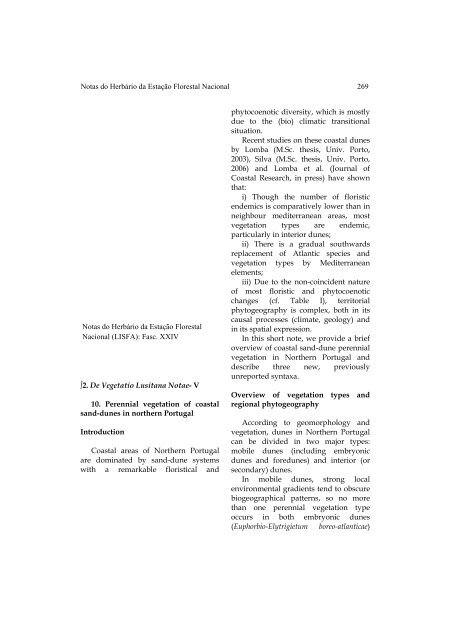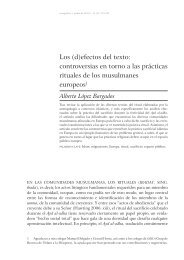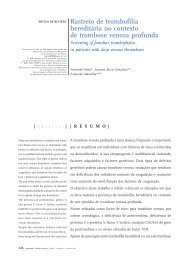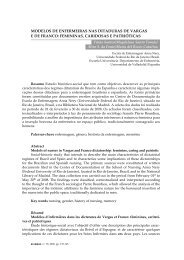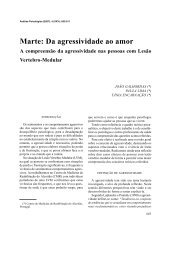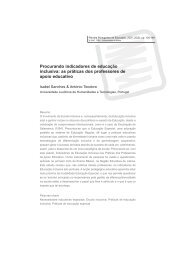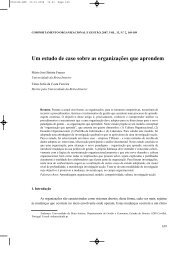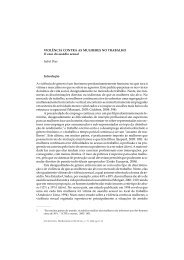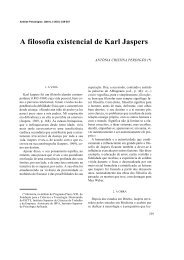LISFA - SciELO - Site
LISFA - SciELO - Site
LISFA - SciELO - Site
You also want an ePaper? Increase the reach of your titles
YUMPU automatically turns print PDFs into web optimized ePapers that Google loves.
Notas do Herbário da Estação Florestal Nacional 269<br />
Notas do Herbário da Estação Florestal<br />
Nacional (<strong>LISFA</strong>): Fasc. XXIV<br />
∫2. De Vegetatio Lusitana Notae- V<br />
10. Perennial vegetation of coastal<br />
sand-dunes in northern Portugal<br />
Introduction<br />
Coastal areas of Northern Portugal<br />
are dominated by sand-dune systems<br />
with a remarkable floristical and<br />
phytocoenotic diversity, which is mostly<br />
due to the (bio) climatic transitional<br />
situation.<br />
Recent studies on these coastal dunes<br />
by Lomba (M.Sc. thesis, Univ. Porto,<br />
2003), Silva (M.Sc. thesis, Univ. Porto,<br />
2006) and Lomba et al. (Journal of<br />
Coastal Research, in press) have shown<br />
that:<br />
i) Though the number of floristic<br />
endemics is comparatively lower than in<br />
neighbour mediterranean areas, most<br />
vegetation types are endemic,<br />
particularly in interior dunes;<br />
ii) There is a gradual southwards<br />
replacement of Atlantic species and<br />
vegetation types by Mediterranean<br />
elements;<br />
iii) Due to the non-coincident nature<br />
of most floristic and phytocoenotic<br />
changes (cf. Table I), territorial<br />
phytogeography is complex, both in its<br />
causal processes (climate, geology) and<br />
in its spatial expression.<br />
In this short note, we provide a brief<br />
overview of coastal sand-dune perennial<br />
vegetation in Northern Portugal and<br />
describe three new, previously<br />
unreported syntaxa.<br />
Overview of vegetation types and<br />
regional phytogeography<br />
According to geomorphology and<br />
vegetation, dunes in Northern Portugal<br />
can be divided in two major types:<br />
mobile dunes (including embryonic<br />
dunes and foredunes) and interior (or<br />
secondary) dunes.<br />
In mobile dunes, strong local<br />
environmental gradients tend to obscure<br />
biogeographical patterns, so no more<br />
than one perennial vegetation type<br />
occurs in both embryonic dunes<br />
(Euphorbio-Elytrigietum boreo-atlanticae)
270<br />
and foredunes (Othantho-Ammophiletum<br />
australis).<br />
On the contrary, interior dunes<br />
include a wide variety of perennial<br />
vegetation types. In dry habitats, as<br />
many as six associations can be found<br />
(Table I): i) nanochamaephytic<br />
vegetation (Ammophiletea: Iberidetum<br />
procumbentis), ii) perennial acidophilous<br />
grasslands (Koelerio-Corynephoretea:<br />
Jasiono-Corynephoretum maritimi and Sedo-<br />
Corynephoretum maritimi), iii) dwarf<br />
shrublands (Calluno-Ulicetea: Ulicetum<br />
latebracteato-minoris; Cisto-Lavanduletea:<br />
Stauracantho-Corematetum albi). The<br />
distribution of these six associations<br />
tends to exhibit a clear phytogeographic<br />
pattern, with Furadouro (Ovar) as a<br />
transitional area between the extreme<br />
North (Galaico-Português sector) and the<br />
dune-systems located along (and south<br />
of) the Aveiro Lagoon (Divisório<br />
Português sector). Vegetation of dune<br />
slacks is of less phytogeographical value,<br />
since only silver-willow (Salix arenaria)<br />
thickets (Rhamno-Prunetea: Holoschoeno-<br />
Salicetum arenariae) and brown-headed<br />
club-rush (Holoschoenus australis)<br />
formations (Molinio-Arrhenatheretea:<br />
Holoschoeno-Juncetum acuti) occur<br />
throughout the area.<br />
New vegetation types<br />
i) Sedo sediformis-Corynephoretum maritimi<br />
as. nova hoc loco (syntype: Table II,<br />
relevé n. 7)<br />
Mediterranean acidophilous perennial<br />
grasslands predominated by<br />
Corynephorus canescens var. maritimus.<br />
Regarding the miniensian association<br />
Jasiono sabulariae-Corynephoretum maritimi,<br />
these coastal-lusitanean grasslands are<br />
well differentiated by the mediterranean<br />
taxa Sedum sediforme (co-dominant),<br />
Cyperus capitatus and Antirrhinum majus<br />
subsp. cirrhigerum.<br />
ii) Iberidetum procumbentis sedetosum<br />
sediformis subas. nova hoc loco (syntype:<br />
Table III, relevé n. 6)<br />
This southern form of the Northwest<br />
Iberian nanochamaephyte-dominated<br />
association Iberidetum procumbentis is<br />
endemic to the coastal-lusitanean dunes<br />
between Furadouro (Ovar) and Figueira<br />
da Foz, and is well discriminated from<br />
the typical form of the association<br />
(iberidetosum procumbentis) by the<br />
mediterranean taxa Sedum sediforme,<br />
Antirrhinum majus subsp. cirrhigerum and<br />
Corema album.<br />
iii) Ulicetum latebracteato-minoris<br />
cistetosum salviifolii subas. nova hoc loco<br />
(syntype: Table IV, relevé n. 5)<br />
Miniensian gorselands predominated<br />
by Ulex europaeus subsp. latebracteatus.<br />
When colonising coastal sand-dunes,<br />
these formations exhibit floristic<br />
peculiarities which discriminate them<br />
from the typical inland Ulicetum<br />
latebracteato-minoris: i) the occurrence of<br />
the mediterranean thermophilous shrubs<br />
Cistus salvifolius (co-dominant) and<br />
Daphne gnidium; ii) the rarity of Ulex<br />
minor and of most Ericaceae; and iii) the<br />
regular occurrence of sand-dune taxa<br />
like Corynephorus canescens var.<br />
maritimus, Pancratium maritimum and<br />
Carex arenaria.<br />
Syntaxonomic scheme (perennial sanddune<br />
vegetation in Northern Portugal)<br />
AMMOPHILETEA Br.-Bl. & Tüxen ex Westhoff,<br />
Dijk & Passchier 1946<br />
Ammophiletalia Br.-Bl. 1933<br />
Ammophilion australis Br.-Bl. 1921 corr. Rivas-<br />
Martínez, Costa & Izco in Rivas-Martínez, Lousã,<br />
T.E. Díaz, Fernández-González & J.C.Costa 1990<br />
Ammophilenion australis Rivas-Martínez & Géhu in<br />
Rivas-Martínez, Costa, Castroviejo & E. Valdês<br />
1980 nom. mut. propos. Rivas-Martínez et al. 2002
Notas do Herbário da Estação Florestal Nacional 271<br />
Otantho maritimi-Ammophiletum australis Géhu<br />
& Tüxen 1975 corr. Fernández Prieto & T.E. Díaz<br />
1991<br />
Honckenyo peploidis-Elytrigion boreoatlanticae Tüxen<br />
in Br.-Bl. & Tüxen nom.mut. propos. Rivas-Martínez<br />
et al. 2002<br />
Elytrigienion boreoatlanticae Rivas-Martínez & Géhu<br />
in Rivas-Martínez, Costa, Castroviejo & E. Valdês<br />
1980 nom. mut. propos. Rivas-Martínez et al. 2002<br />
Euphorbio paraliae-Elytrigietum boreoatlanticae<br />
Tüxen in Br.-Bl. & Tüxen 1952 nom. mut. propos.<br />
Rivas-Martínez et al. 2002<br />
Crucianelletalia maritimae Sissingh 1974<br />
Helichrysion picardii (Rivas-Martínez, Costa & Izco<br />
in Rivas-Martínez, Lousã, T. E. Díaz, Fernández-<br />
González & J.C. Costa 1990) ex Rivas-Martínez,<br />
Fernández-González & Loidi 1999<br />
Iberidetum procumbentis Bellot 1996<br />
sedetosum sediformis subas. nova hoc loco<br />
CALLUNO-ULICETEA Br.-Bl. & Tüxen ex Klika &<br />
Hadač 1944<br />
Ulicetalia minoris Quantin 1935<br />
Daboecion cantabricae (P. Dupont ex Rivas-Martínez<br />
1979) Rivas-Martínez, Fernández-González & Loidi<br />
1999<br />
Ulicetum latebracteato-minoris (Br.-Bl., P. Silva &<br />
Rozeira 1964) Rivas-Martínez 1979<br />
cistetosum salviifolii subas. nova hoc loco<br />
CISTO-LAVANDULETEA Br.-Bl. in Br.-Bl.,<br />
Molinier & Wagner 1940<br />
Stauracantho genistoidis-Halimietalia commutati<br />
Rivas-Martínez, Lousã, T.E. Díaz, Fernández-<br />
González & J.C. Costa 1990<br />
Coremation albi Rothmaler 1954<br />
Stauracantho genistoidis-Coremetum albi Br.-Bl.,<br />
P. Silva & Rozeira 1964<br />
CYTISETEA SCOPARIO-STRIATI Rivas-Martínez<br />
1974<br />
Cytisetalia scopario-striati Rivas-Martínez 1974<br />
Ulici europaei-Cytision striati Rivas-Martínez,<br />
Báscones, Díaz, Fernandez-González & Loidi 1991<br />
Ulici latebracteati-Cytisetum striati Rivas-<br />
Martínez ex J.C. Costa, Izco, Lousã, Aguiar &<br />
Capelo in J.C. Costa, Capelo, Lousã, Antunes,<br />
Aguiar, Izco & Ladero 2000<br />
cytisetosum grandiflori J.C. Costa, J. Honrado & J.<br />
Izco in J.C. Costa, Aguiar, Capelo, Lousã, Antunes,<br />
J. Honrado, J. Izco & Ladero 2003<br />
KOELERIO-CORYNEPHORETEA Klika in Klika &<br />
Novák 1941<br />
Corynephoretalia canescentis Klika 1934<br />
Koelerion arenariae Tüxen 1937 nom. mut. propos.<br />
Rivas-Martínez et al. 2002<br />
Jasiono sabulariae-Corynephoretum maritimi A.<br />
Lomba, P. Alves & J. Honrado (in press)<br />
Sedo sediformis-Corynephoretum maritimi as. nova<br />
hoc loco<br />
MOLINIO-ARRHENATHERETEA Tüxen 1937<br />
Holoschoenetalia Br.-Bl. ex Tchou 1948<br />
Molinio-Holoschoenion vulgaris Br.-Bl. ex Tchou 1948<br />
Brizo-Holoschoenenion (Rivas Goday 1964) Rivas-<br />
Martínez in Rivas-Martínez, Costa, Castroviejo & E.<br />
Valdés 1980<br />
Holoschoeno-Juncetum acuti Rivas-Martínez &<br />
Costa in Rivas-Martínez, Costa, Castroviejo & E.<br />
Valdés 1980<br />
RHAMNO-PRUNETEA Rivas Goday & Borja ex<br />
Tüxen 1962<br />
Salicetalia arenariae Preising & Weber in Weber<br />
1999<br />
Holoschoeno australis-Salicion arenariae Neto, J.C.<br />
Costa, Capelo & J. Honrado 2004<br />
Holoschoeno australis-Salicetum arenariae M.J.<br />
Martins & Penas ex. J.C. Costa, Neto, Capelo &<br />
Lousã 2002<br />
Nomenclature<br />
Scientific names of plant taxa are<br />
mostly according to Castroviejo et al.<br />
(Flora Iberica, 1986-2003) as far as issued,<br />
and Franco and Franco & Rocha Afonso<br />
(Nova Flora de Portugal, 1971-2003) for<br />
other groups. Syntaxonomic nomenclature<br />
for higher groups and phytogeographic<br />
units are according to Rivas-<br />
Martínez et al. (Itinera Geobotanica 15,<br />
2002).<br />
J. Honrado 1,2 , P. Alves 1 , A. Lomba 1 , J.<br />
Vicente 1 , G. Silva 3 , H. Nepomuceno 4<br />
F. Barreto Caldas 1,2 : 1 CIBIO-Centro de<br />
Investigação em Biodiversidade e<br />
Recursos Genéticos, Universidade do<br />
Porto (Portugal), 2 Faculdade de<br />
Ciências, Universidade do Porto<br />
(Portugal), 3 Reserva Natural das Dunas<br />
de S. Jacinto, Instituto da Conservação<br />
da Natureza (Portugal), 4 Parque<br />
Biológico de Gaia (Portugal).
272<br />
Table I - Overview of perennial sand-dune vegetation types of dry habitats occurring in<br />
selected dune systems along Northern Portugal (adapted from Silva 2006)<br />
<strong>Site</strong> (Northern<br />
Portugal)<br />
Apúlia<br />
Furadouro<br />
Torreira<br />
S. Jacinto<br />
Mira/Quiaios<br />
Cova Gala<br />
Ammophiletea of<br />
Ammophiletea of<br />
foredunes<br />
embryonic dunes<br />
(primary dunes)<br />
Euphorbio<br />
paraliae-<br />
Agropyretum<br />
junceiformis<br />
Otantho maritimi-<br />
Ammophiletum<br />
australis<br />
Loto cretici-<br />
Ammophiletum<br />
australis<br />
Vegetation type<br />
Ammophiletea of<br />
interior (secondary)<br />
dunes<br />
Iberidetum<br />
procumbentis<br />
iberidetosum<br />
procumbentis<br />
Iberidetum<br />
procumbentis<br />
sedetosum<br />
sediformis<br />
Acidophilous<br />
grasslands<br />
(Corynephoretea) of<br />
interior dunes<br />
Jasiono sabulariae-<br />
Corynephoretum<br />
maritimi<br />
Sedo sediformis-<br />
Corynephoretum<br />
maritimi<br />
Dwarf shrublands<br />
(Calluno-Ulicetea,<br />
Cisto-<br />
Lavanduletea)<br />
Ulicetum<br />
latebracteatominoris<br />
cistetosum<br />
salviifolii<br />
Stauracantho<br />
genistoidis-<br />
Corematetum albi<br />
Table II - Sedo sediformis-Corynephoretum maritimi as. nova.<br />
Relevé n. 1 4 2 3 5 6 7 8 9 10 11<br />
N. of taxa 5 6 6 6 7 7 8 9 10 11 11<br />
Characteristic and differential taxa<br />
Corynephorus maritimus 2 3 3 3 2 2 3 2 2 3 2 11<br />
Sedum sediforme 1 1 2 2 2 1 2 1 1 1 1 11<br />
Herniaria robusta . + 1 + 1 + + 1 + 1 1 10<br />
Antirrhinum cirrhigerum . + + . . . 1 + 1 + + 7<br />
Cyperus capitatus 1 . . 1 1 + 1 . 2 1 . 7<br />
Malcolmia littorea . . . . . . . . + 1 . 2<br />
Paronychia argentea . . . . . . . 1 . . 1 2<br />
Carex arenaria . . . . . . . . 1 . . 1<br />
Linaria decumbens . . . . . . . . . . + 1<br />
.<br />
Companion taxa<br />
Vulpia alopecuros . 1 . 1 + 1 1 2 1 1 1 9<br />
Lagurus ovatus . . . 1 + . + 1 . + . 5<br />
Erodium bipinnatum + . . . + + + . . . . 4<br />
Silene niceensis . . + . . . . + . + + 4<br />
Xolantha guttata . + . . . . . 1 . . 1 3<br />
Pancratium maritimum . . + . . . . . + . . 2<br />
Seseli tortuosum . . . . . . . . + 1 . 2<br />
Aetheorhiza bulbosa . . . . . . . . + . 1<br />
Calystegia soldanella + . . . . . . . . . . 1<br />
Euphorbia portlandica . . . . . . . . . . + 1<br />
Plantago coronopus . . . . + . . . . . 1<br />
Reichardia gaditana . . . . . . . . . . + 1
Notas do Herbário da Estação Florestal Nacional 273<br />
<strong>Site</strong>s:<br />
Rel. 1: MIRA: north of Praia de Mira, 29TNE1779.<br />
Rel. 2: FIGUEIRA DA FOZ: Cova Gala, 29TNE1141.<br />
Rels. 3,4: JACCO1 AVEIRO: S. Jacinto, 29TNF2202.<br />
Rels. 5,6: MIRA: north of Praia de Mira, 29TNE1779.<br />
Rel. 7: AVEIRO: S. Jacinto, 29TNF2202.<br />
Rels. 8,11: FIGUEIRA DA FOZ: Cova Gala, 29TNE1141.<br />
Rels. 9,10: MURTOSA, Torreira, 29TNF2412.<br />
Table III - Iberidetum procumbentis sedetosum sediformis subas. nova.<br />
Relevé n. 1 2 3 5 4 6 7 8 9 10 11<br />
N. of taxa 8 11 12 13 13 14 14 16 18 18 19<br />
Characteristic taxa<br />
Ammophila arundinacea 1 + 1 1 + + 1 1 3 1 1 11<br />
Helichrysum picardii 2 2 2 3 2 2 3 2 2 2 2 11<br />
Crucianella maritima 4 3 3 1 3 2 1 2 . 2 1 10<br />
Pancratium maritimum + . + + . . + + + + 1 8<br />
Artemisia crithmifolia . . . 2 + . 2 2 3 2 3 7<br />
Medicago marina . . 1 1 1 . 2 . 1 1 1 7<br />
Silene niceensis 1 . . + 1 + . 1 + + 7<br />
Seseli tortuosum . . 2 . 2 + . . 2 1 1 6<br />
Anagallis microphylla + . . + + . . . + + . 5<br />
Calystegia soldanella . + + . + + . . . + 5<br />
Aetheorhiza bulbosa . . . . . . . . 2 1 . 2<br />
Elytrigia boreo-atlantica . . + . . . + . . . 2<br />
Eryngium maritimum . + . + . . . . . . . 2<br />
Iberis procumbens . 1 . . . 1 . . . . . 2<br />
Otanthus maritimus . + . . + . . . . . . 2<br />
Reichardia gaditana . . . . . . + + . . . 2<br />
Scrophularia frustescens . . + . + . . . . . . 2<br />
Differential taxa<br />
Sedum sediforme 2 1 1 1 2 2 1 1 2 1 1 11<br />
Corema album . + 1 . 1 + . 1 1 . . 6<br />
Antirrhinum cirrhigerum . 1 . . . + . + . 1 + 5<br />
Verbascum litigiosum . . + . + . . . . . . 2<br />
Companion taxa<br />
Vulpia alopecuros + . . 1 . . + 1 1 + 1 7<br />
Corynephorus maritimus + . + 1 . . 1 . . 1 1 6<br />
Herniaria robusta . . . + . + . . . 1 + 4<br />
Erodium bipinnatum . . . . . . + . . . + 2<br />
Jasione sabularia . . . . . . . 1 + . 2<br />
Lagurus ovatus . . . . . + . . . . + 2<br />
Linaria decumbens . . . . . + . + . . . 2<br />
Malcolmia littorea . . . . . . . . . + + 2<br />
Plantago coronopus . . . . . . . . 2 + . 2<br />
Silene littorea . . . . . + + . . . . 2<br />
Carex arenaria . . . . . . . . 1 . . 1<br />
Cistus salviifolius . . . . . . 1 . . . 1
274<br />
Table III – Cont.<br />
Relevé n. 1 2 3 5 4 6 7 8 9 10 11<br />
N. of taxa 8 11 12 13 13 14 14 16 18 18 19<br />
Companion taxa<br />
Cyperus capitatus . . . . . . . 1 . . . 1<br />
Evax ramosissima . . . . . . . . 2 . . 1<br />
Hypochoeris radicata . . . . . . . 1 . . 1<br />
Paronychia argentea . . . . . . . + . . . 1<br />
Polycarpon diphyllum . . . . . . . . . . + 1<br />
Sedum album . . . . . . + . . . 1<br />
Senecio gallicus . . . . . . . . . . + 1<br />
Trifolium arvense . . . . . . . + . 1<br />
<strong>Site</strong>s:<br />
Rel. 1: MIRA: south of Praia de Mira, 29TNE1677.<br />
Rels. 2,6: AVEIRO: S. Jacinto, 29TNF2202.<br />
Rels. 3,5: FIGUEIRA DA FOZ: Praia de Quiaios, 29TNE0952.<br />
Rels. 4,7: MIRA: north of Praia de Mira, 29TNE1779.<br />
Rels. 8: FIGUEIRA DA FOZ: Cova Gala, 29TNE1141.<br />
Rels. 9: OVAR: Furadouro, 29TNF2723.<br />
Rels. 10,11: MURTOSA, Torreira, 29TNF2412.<br />
Table IV - Ulicetum latebracteato-minoris cistetosum salviifolii subas. nova.<br />
Relevé n. 1 2 3 4 5 6<br />
N. of taxa 8 8 9 10 13 14<br />
Characteristic taxa<br />
Ulex latebracteatus 4 5 4 3 4 4 6<br />
Ulex minor 1 . 1 . . . 2<br />
Cistus psilosepalus . 2 . . . . 1<br />
Cuscuta kotschyii . . 1 . . . 1<br />
Differential taxa<br />
Cistus salviifolius 3 2 3 4 3 4 6<br />
Carex arenaria 1 1 . . + + 4<br />
Daphne gnidium . . 2 1 1 + 4<br />
Corynephorus maritimus . . . + + + 3<br />
Pancratium maritimum . . . + + + 3<br />
Ammophila arundinacea . . . + + . 2<br />
Seseli tortuosum . . . + + . 2<br />
Euphorbia portlandica . . . . . + 1<br />
Helichrysum picardii . . . . . + 1<br />
Myrtus communis . . . . . + 1<br />
Companion taxa<br />
Quercus suber . . 1 + 1 + 4<br />
Quercus robur 1 1 1 . . . 3<br />
Rubus ulmifolius . 2 . . + + 3<br />
Brachypodium rupestre 2 2 . . . . 2
Notas do Herbário da Estação Florestal Nacional 275<br />
Table IV – Cont.<br />
Relevé n. 1 2 3 4 5 6<br />
N. of taxa 8 8 9 10 13 14<br />
Companion taxa<br />
Briza maxima . . 1 + 2<br />
Crataegus monogyna . . . + . + 2<br />
Dactylis lusitanica 1 . 2 . . 2<br />
Leontodon taraxacoides . . . . + + 2<br />
Scirpoides holoschoenus . . . + . + 2<br />
Carpobrotus edulis 1 . . . . . 1<br />
Lagurus ovatus . . . . + . 1<br />
Pteridium aquilinum . 2 . . . . 1<br />
<strong>Site</strong>s:<br />
Rels. 1-3: VILA DO CONDE: Árvore, 29TNF2275.<br />
Rels. 4-6: ESPOSENDE: Apúlia, 29TNF1991.


